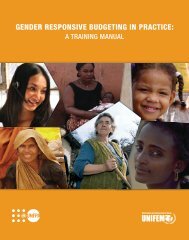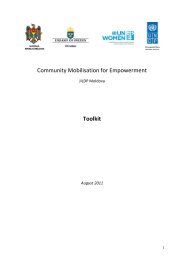Gender Responsive Budgeting and Women's Reproductive Rights ...
Gender Responsive Budgeting and Women's Reproductive Rights ...
Gender Responsive Budgeting and Women's Reproductive Rights ...
You also want an ePaper? Increase the reach of your titles
YUMPU automatically turns print PDFs into web optimized ePapers that Google loves.
Box 15: What is the cost of combating domestic violence?NGO examination of budget allocations for GBV started in the second year of South Africa’s Women’s Budget Initiative (WBI), witha chapter that looked at how the budgets of the Departments of Safety & Security (police) <strong>and</strong> Justice catered for this problem.In 1999 South Africa got a new <strong>and</strong> improved Domestic Violence Act. In June 1998 the <strong>Gender</strong> Advocacy Program (GAP) organisedan information session for NGOs about the WBI <strong>and</strong> how government budgets are allocated. At a second workshop GAP <strong>and</strong>its partners agreed that research was needed to see how much government was allocating to implement the new Act.The research found that some new money was allocated to train police officers <strong>and</strong> court officers on the new Act. The governmentalso allocated money to produce posters <strong>and</strong> brochures <strong>and</strong> for other publicity <strong>and</strong> awareness-raising. Much of the money forthese purposes was provided by donors.Three years later, the NGO Centre for the Study of Violence <strong>and</strong> Reconciliation (CSVR) did research in which they asked policeofficials how much they allocated to implement GBV-related work. Again, the allocations were mainly for training <strong>and</strong> awarenessraising. But there were also some general allocations, for example for infrastructure, that police said would help in implementingthe act.In 2005 CSVR decided to find out how much ought to be allocated to implement the Domestic Violence Act. They did this by askingall the different government officers involved in implementation how long they spent on a typical case. The time was then multipliedby the relevant salary, <strong>and</strong> the total amount for a single case multiplied by the estimated number of cases in the country.Reference: Vetten, L. “Show Me the Money”: A Review of Budgets Allocated towards the Implementation of SouthAfrica’s Domestic Violence Act. Politikon 32(2) (2005): 277-295.Budget work <strong>and</strong> good governance <strong>and</strong> participationSome GRB initiatives focus only on the content of budgets. Others include a focus on the process .of budget-making. Some of these initiatives look at what opportunities there are for members of thelegislature, as elected representatives of civil society, to influence the budget. Where opportunities exist,the GRB initiatives can try to assist the representatives (<strong>and</strong> the female ones in particular) to engagemeaningfully by helping them underst<strong>and</strong> budgets <strong>and</strong> budget process. Thus the Forum for Women inDemocracy (FOWODE) in Ug<strong>and</strong>a first assisted women to st<strong>and</strong> for local government elections. Oncethey were elected, FOWODE provided training for the women councillors in GRB so that they couldeffectively represent women’s interests in their new role.Some GRB initiatives also look at opportunities for civil society organisations to engage with budgetprocesses. Ug<strong>and</strong>a is again an example of good practice on this matter. The Ug<strong>and</strong>an government hasestablished sector working groups which are involved early on in the planning <strong>and</strong> budgeting cycle.These sector working groups include representatives from civil society organisations with expertise in thesector. FOWODE is one of the civil society organisations that are part of a sector working group.It is more common, however, for government to provide opportunities for civil society participation at thelocal rather than the national level. For the most part, these initiatives focus on the investment side of thebudget rather than the recurrent budget that covers items such as salaries. Latin America has been theleader in participation at the local government level. Some of the processes do not make special effortsto ensure that all voices—<strong>and</strong> particularly those of women 0f women—are heard. However, there aresome examples where special efforts are made as a result of advocacy.46 U s i n g t h e b u d g e t a n g l e t o a d v a n c e o t h e r w o r k





